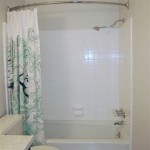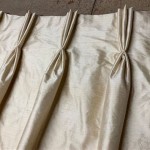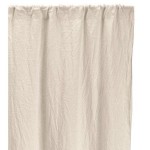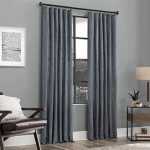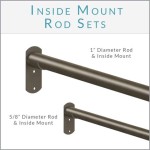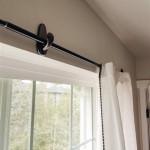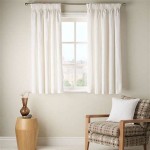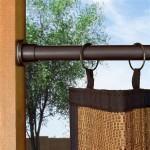Selecting the Right Outdoor Curtain Rod for Your Patio
Outdoor curtain rods are essential components for creating comfortable and aesthetically pleasing patio spaces. Choosing the appropriate rod involves careful consideration of several factors, including material, style, weight capacity, and installation method. A well-selected outdoor curtain rod enhances privacy, provides shade, and adds decorative flair to your outdoor living area, transforming it into a welcoming and functional extension of your home.
The longevity and performance of an outdoor curtain rod are directly influenced by the materials used in its construction. Exposure to the elements necessitates robust and weather-resistant materials that can withstand varying temperatures, humidity, and precipitation. Selecting the right material is crucial for ensuring that the curtain rod remains functional and aesthetically appealing for years to come.
Material Considerations for Outdoor Curtain Rods
Several materials are commonly used in the manufacturing of outdoor curtain rods, each offering distinct advantages and disadvantages. Understanding these differences is critical for making an informed decision based on your specific needs and environmental conditions.
Stainless Steel: Stainless steel is a popular choice due to its superior corrosion resistance. This material is particularly well-suited for coastal environments or areas with high humidity, where rust is a significant concern. Stainless steel curtain rods are durable, strong, and can support heavier curtains without bending or sagging. The sleek and modern appearance of stainless steel complements a variety of outdoor décor styles.
Aluminum: Aluminum is another lightweight and corrosion-resistant option. It is less expensive than stainless steel, making it an attractive choice for budget-conscious consumers. Aluminum curtain rods are relatively easy to install and can withstand moderate weather conditions. However, aluminum is not as strong as stainless steel and may be more prone to bending or damage under heavy loads or strong winds.
Powder-Coated Steel: Powder-coated steel offers a combination of strength and weather resistance. The powder coating provides a protective layer that helps prevent rust and corrosion. Powder-coated steel curtain rods are available in a wide range of colors and finishes, allowing for greater customization options. While durable, the powder coating can chip or scratch over time, exposing the underlying steel to potential corrosion.
Wrought Iron: Wrought iron curtain rods offer a classic and elegant aesthetic. This material is incredibly strong and durable, capable of supporting heavy curtains and withstanding harsh weather conditions. However, wrought iron is susceptible to rust and requires regular maintenance, such as painting or sealing, to prevent corrosion. The heavier weight of wrought iron can also make installation more challenging.
Wood: While less common, wood curtain rods can add a natural and rustic touch to outdoor spaces. Wood is susceptible to moisture damage and rot, so it is essential to choose a weather-resistant type of wood, such as cedar or teak, and to apply a protective sealant or stain. Regular maintenance is required to preserve the wood's appearance and prevent deterioration.
The choice of material should be based on a compromise between aesthetic appeal, durability, and budget. Higher quality materials require a higher initial investment but often offer long-term value due to their extended lifespan and reduced maintenance needs.
Styles and Design Considerations
Outdoor curtain rods are available in a variety of styles and designs to complement different architectural styles and personal preferences. The style of the curtain rod can significantly impact the overall aesthetic of your patio space.
Tension Rods: Tension rods are easy to install and require no drilling or hardware. They are held in place by tension and are suitable for lightweight curtains. However, tension rods are not as strong or secure as other types of curtain rods and may not be suitable for heavy curtains or areas with strong winds.
Standard Rods with Brackets: Standard curtain rods with brackets are the most common type of outdoor curtain rod. They provide a secure and stable support for curtains and are available in a wide range of materials, styles, and finishes. The brackets are typically attached to the wall or ceiling using screws and anchors. The selection of appropriate brackets is critical for ensuring the rod's weight capacity is not exceeded. The brackets should be crafted from a material that matches the durability of the rod itself.
Traverse Rods: Traverse rods are designed for curtains that are opened and closed frequently. They feature a track system that allows the curtains to glide smoothly along the rod. Traverse rods are ideal for creating privacy or blocking sunlight. These are often more complex to install and may require specialized hardware.
Decorative Rods: Decorative curtain rods feature ornate designs and finials, adding a touch of elegance to outdoor spaces. These rods are available in a variety of styles, from classic to contemporary. The finials at the end of the rod serve a decorative purpose but also prevent the curtains from slipping off the rod. Special attention should be given to selecting finials that are also weather-resistant.
Rod Diameter: The diameter of the curtain rod should be chosen based on the weight and size of the curtains. Heavier curtains require a thicker rod to prevent sagging. A larger diameter rod also tends to provide a more substantial and visually appealing look.
In addition to the style of the rod, the color and finish should also be considered. Choose a color that complements the surrounding décor and architectural features. Powder-coated finishes are a popular choice for outdoor curtain rods due to their durability and resistance to fading.
Installation and Maintenance of Outdoor Curtain Rods
Proper installation and regular maintenance are essential for ensuring the longevity and performance of outdoor curtain rods. Incorrect installation can lead to instability and premature failure, while neglected maintenance can result in corrosion and damage.
Installation: Before installing an outdoor curtain rod, carefully measure the space where the curtains will be hung. Ensure that the rod is long enough to accommodate the curtains and that the brackets are positioned correctly for optimal support. Use a level to ensure that the rod is installed straight and even. For heavier curtains, consider using wall anchors to provide additional support. Proper tools, such as a drill, screwdriver, and measuring tape, are essential for a successful installation.
Maintenance: Regular cleaning is essential for removing dirt, dust, and debris from outdoor curtain rods. Use a mild detergent and water to clean the rod and brackets. Avoid using abrasive cleaners, as they can damage the finish. For wrought iron curtain rods, apply a rust-inhibiting sealant or paint periodically to prevent corrosion. Check the brackets regularly to ensure that they are securely attached to the wall or ceiling. Tighten any loose screws or bolts. In areas with strong winds, consider using tiebacks or weights to prevent the curtains from blowing around and damaging the rod.
Seasonal Considerations: In regions with harsh winters, it may be necessary to remove the curtains from the rod and store them indoors to prevent damage from snow and ice. Inspect the curtain rod and brackets for any signs of damage or wear and tear before the start of each outdoor season. Addressing any minor issues promptly can prevent them from escalating into more serious problems.
The proper care and maintenance of outdoor curtain rods will contribute significantly to their lifespan and ensure they continue to enhance the beauty and functionality of your patio space for years to come. Ignoring these preventative measures can lead to early replacement costs.
Ultimately, selecting the right outdoor curtain rod for your patio requires careful consideration of material, style, and installation. By evaluating these factors in relation to your specific needs and preferences, you can create an outdoor living space that is both comfortable and aesthetically pleasing.

How To Hang Outdoor Drapes Diy Curtain Rods Polka Dot Chair

Yinrunx Outdoor Curtains For Patio Waterproof Curtain Rod Rods Extra Long Weatherproof

How To Make Outdoor Curtain Rods Four Generations One Roof

Choosing And Hanging Outdoor Curtains The Home

Outdoor Curtain Rods Hardware Patio Drapery

Yinrunx Outdoor Curtains For Patio Waterproof Curtain Rod Rods Extra Long Weatherproof Wal Com

Diy Floating Outdoor Curtain Rod Creating A Privacy Curtains For Deck

Diy Floating Outdoor Curtain Rod Creating A Privacy Curtains For Deck

Leonard Outdoor Curtain Curtains For Patio Rod Waterproof Rods Extra Long Bamboo Weatherproof Wal Com

How To Make Outdoor Curtain Rods Four Generations One Roof

